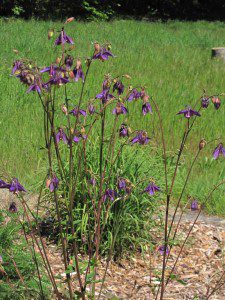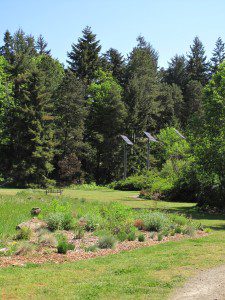
Written by Deborah Phare, Seattle Parks and Recreation Volunteer

Graceful stems of old-fashioned Columbine (Aquilegia vulgaris) in the Prairie Garden. Photo by Lorene Edwards Forkner
Public demonstration gardens begin with idealism, hope, and the best of intentions. In the mid-1990s, a small but ambitious project was undertaken in Carkeek Park, a 216-acre public park in north Seattle. With the help of many volunteers, a few Parks and Recreation department employees, and funding from two generous grants, gardens beds were installed adjacent to a meadow in a large open area behind the park’s administration buildings. The goal was to show the diversity of plants that could easily and successfully be grown in the Pacific Northwest without the use of fertilizers, insecticides, or pesticides, and with little-to-no supplemental water. Each bed focused on different soil and growing conditions that challenge gardeners in our region. Eights beds demonstrated a variety of plantings including a kitchen garden, woodland shade, a rain garden, a blue garden, and various plantings for pollinators and of Western natives.
But maintaining a garden requires attention and resources. And, as often happens with projects fueled primarily by volunteer effort, over time the demonstration gardens suffered from want of care and, eventually, neglect. Occasionally, staff would prune large shrubs and small trees to clear pathways, but no weeding was done. The garden beds became overgrown and many plants died.
The first time I saw the gardens, in late summer 2009, I was greeted by a weedy tangle of creeping buttercup, bindweed, Geranium robertianum, Daphne laureola, English ivy, creeping woodsorrel, and a small stand of noxious knotweed just for variety. An enormous hop vine covered half of one bed and Spiraea douglasii covered the other half. Another bed was completely overgrown by a thicket of baldhip rose (Rosa gymnocarpa). I was intrigued by the once ample wealth of plant material as evidenced by labels for plants long since shaded out, and challenged by the enthusiastic health of weeds. If nothing else, it spoke well of the soil.
With the intention of offering to help, I asked the park’s naturalist who was in charge of maintenance. I was told that limited staff tended the gardens only as time allowed, but if I was interested, please speak up! So, with input from the naturalist, I committed to a few days each month to weed and do small pruning jobs. Slowly I began to uncover a few valuable plants, long hidden but still healthy, and struggling to grow. Among the surprises were Lewisia tweedyi, Hebe andersonii, yellow-eyed grass (Sisyrinchium californicum), Starflower (Trientalis borealis), Penstemon barrettiae, and a struggling Carpenteria californica suffocating under the hops.

The just-emerging Prairie Garden in spring backed by grasses and wildflowers in the lush meadow. Photo by Lorene Edwards Forkner
Within my first year of volunteering, city budget cuts reduced staff to just one employee who was responsible for the beach, a playground, picnic areas, and many miles of forested trails. Necessity dictated that garden maintenance be dropped. The thought of losing the gardens was intolerable, so after much thought I contacted the Parks department and asked to be assigned as garden steward. A written agreement was developed that entailed a three-year commitment, a weekly work schedule, and defined parameters. I began by developing a restoration plan that included plant requests, requests for additional help, outreach to the Edmonds Community College Horticulture department, and long-term goals for the landscape. A few months after signing the agreement, Drexie Malone, a Master Gardener, joined me in this work. Between the two of us, and with the help of occasional summer interns and volunteers, the demonstration gardens at Carkeek Park are developing into a vibrant, healthy landscape with a wide variety of Pacific Northwest native and non-native but harmonious plants.
In May 2013, I was given permission to add a new garden bed to the group—a prairie-style planting that would introduce a variety of ornamental grasses and perennials to the landscape. Ornamental grasses are the bones of this garden and the tall, elegant Sorghastrum nutans ‘Indian Steel’ is its star. The prairie-style garden is at its most beautiful in autumn when the grasses come into color. An important feature of this new area is that it requires the least amount of care of all the demonstration beds; the new plantings were watered through summer of 2013 but have received no supplemental water since and plants are thriving in this full sun, rich soil environment.
After removing enormous numbers of dead plants over the past three years (and a disturbing amount of garbage), gaps in coverage enabled weeds to repopulate the demonstration beds with astounding speed. We are alleviating the problem by adding more plants and deep layers of mulch.
As the variety of plant material increases, so follows our pollinator population. Tiger swallowtail, painted lady, red admiral, spangled fritillary, and mourning cloak butterflies are regularly seen on blooms throughout spring and summer. An occasional woodland skipper makes a trip through the gardens, as well. The population and variety of bees increases yearly and now includes mason bees as well as other native species. Our resident hummingbird population is growing and we hear them when our work intrudes into their territory! And Cooper’s hawks and bald eagles frequently soar above us in the morning as we work near the meadow.
Working in the demonstration gardens presents many challenges: repairing dog-damaged plants, reversing the peculiar work of a guerrilla gardener, the never-ending search for a budget for plants and materials, and recruiting volunteers and interns. But these issues aside, I’m always discovering something new and delightful about our plants, the wildlife, and interactions between them. It is gratifying to hear visitors to the gardens express appreciation and interest with questions that range from “What is that plant?” to “I have a black thumb; what can I plant that will live in spite of my efforts?” and “Should I try to grow this at home?”

Sweet Joe-Pye weed (Eutrochium purpureum syn. Eupatorium purpureum) is a pollinator and butterfly favorite when it blooms in summer. Photo by Luke McGuff
Along the way, our project has been the fortunate recipient of expert help and guidance, from plant identification and donations, to the building of new beds, and yearly pruning. Walt Bubelis, Professor Emeritus, and Gene Pennock, landscaping and pruning instructor, from Edmonds Community College, have played important roles in the restoration of the demonstration gardens. The gardens would not be at this level of development without their help, and Drexie and I are very grateful.
The demonstration gardens at Carkeek Park are one of Seattle’s little-known but important horticultural gems. As the plantings develop and mature, their importance to the surrounding forest, creek, and neighborhood environments grows in countless ways. Visitors can gather planting and design ideas for their personal landscapes, glean valuable information about increasing pollinator populations and wildlife habitat, and develop a deeper understanding of, and appreciation for, the importance of the beneficial plants that support these systems. And they can leave refreshed and renewed from a pleasant walk in a quiet garden.
###
This story first appeared in the Summer 2015 issue of Pacific Horticulture magazine.
www.pacifichorticulture.org.